Introduction
Speaking has always been a skill highly favoured by employers around the globe when it comes to graduates’ employability skills. Similarly, in Malaysia, the Malaysian Employers Federation (MEF) has often voiced in reports how significant this skill is in attaining employment (Suzana Ab. Rahim, Mah Boon Yih, & Zarina Suriya Ramlan 2017). The Tracer Graduate Study also indicates some percentage of likelihood of the graduates have a higher chance of being employed if their speaking skill is better or polished (Ministry of Higher Education, 2012). Given their flawed English language competence, especially where speaking skill is concerned, there is a dire need to initiate the urgency of how such incompetence can be addressed and diminished amongst the graduates our Higher Education Providers (HEPs) produced.
In the effort to make the graduates more marketable, a few HEPs have taken the initiative to uptake an exit test similar to the ones conducted by other varsities around the globe; for instance, Hong Kong Polytechnic or University undertaking The Graduating Students’ Language Proficiency Assessment (GSLPA) (English) is a reliable and accurate assessment of candidates’ proficiencies in written and spoken English for workplace communication (Urmston, 2003). To provide employers with an updated and accurate proficiency description, the exit test should be valid credence for future employees to validate their competence to the employers. In Malaysia and Universiti Teknologi MARA (UiTM), the English Exit Test (EET) is expected to be a standard measure of graduates’ English proficiency across all branch universities. It would enable the stakeholders, such as employers, the universities, and the government, to make more informed decision regarding workplace recruitment and English language enhancement provision to the graduating students (Ministry of Education Malaysia Higher Education, 2018).
In addition to this, as stated by Farina Tazijan, Rofiza Aboo Bakar, & Nor Fazlin Mohd Ramli (2022), it is of significance that the 21st Century Digital Skills, which comprise seven core skills, namely technical, information management, communication, collaboration, creativity, critical thinking, and problem-solving, be implemented and instilled in learners. Such dependence would be favorable for the future employment of these graduates.
Problem Statement
In 2014, the Malaysian Employers Federation (MEF) Secretary lamented how over 25% of the graduates were unemployed and that this is partly due to their inability to communicate in English (“English proficiency will… Sept 3, 2014). Meanwhile, statistics from the MEF in 2016 show that 200,000 local graduates were unemployed, with poor command of English being the main reason (Rebecca Rajaendram, 2016). As such, the local graduates produced related HEPs may end up less appealing to future employees.
Some reasons for poor communication skills, especially in speaking, have been cited to include the class conditions which do not favour oral activities. It has limited opportunities for students to practise outside of class, and the examination system does not emphasise oral skills (Richards, 2009). Similarly, the lack of exposure and chances for these learners to explore their speaking skills in our backyard has resulted in poor competence and performance, which could also be the aftermath of the mismatches between the education system and the expectations of the employees or industry.
Aligning to the goals of Industrial Revolution 4.0 (IR4.0), the HEP has propagated learners’ autonomy in learning. These creative and innovative ways interwoven with technology made available have been present and are here to stay for quite some time. However, without the proper guidance from the respective lecturers, the essence of such a learning process will be lost. Hence, it is important that the authentic materials catering to the needs of the learners are carefully selected and developed by the relevant HEP educators following the course outcomes and rubrics or result in students being lost and confused in the exchange of online information.
As underlined by Ikhsanudin Ikhsanudin & Dwi Susanto Ali Purwoko (2022), there are certain functions that any media are held accountable for before being utilised in the process of teaching and learning. These include simulation, mediation and information of the media in simulating and engaging the learners in the learning process via technology. As such, this could justify why such online media could be more appealing based on the rapid changes in our education.
Other than these justifications, where the HEPs are concerned, the lack of time for these undergraduates to undergo a formal class meant to spruce up their workplace requirements is, thus, a valid reason to opt for integrated e-learning the resources provided by the HEPs. The LMS and blogging are only two of many other means of getting the learners to take up speaking skills in an even more positive manner. As such, the development of a portal is deemed necessary since no formal learning or course is conducted by the HEP for the graduating students.
Objectives of study
This article aims to introduce an online instructional platform, EET Online Speaking Portal, created as an outcome of technology embracement to improve speaking. Specifically, this paper intends to highlight the descriptions of ther features and functions of this portal together with the relevant procedures to be taken by the EET test-takers in familiarising themselves with this speaking test. The objectives of creating this online portal are as follows:
1. OOffer test-takers the EET resources to increase their readiness and familiarity beforetaking the speaking test.
2. Provide an avenue for students to practice the mock EET speaking tests before the actual test.
Significance of study
Knowledge transfer has been made possible even faster with the advent of technology. With advancement comes increased expectations from the industry for their future employees to be workplace-compliant in terms of both hard and soft skills. To do so, a graduate’s ability to apply and use language in the workplace is significantly more important than having his or her proficiency. Thus, there is a need to provide learners with sufficient learning resources for enhancing their speaking skills, whereby they will be exposed to the common questions and tasks as often asked in a job interview.
In today’s higher education, especially with the recent development of major health concerns affecting the world, learning is no longer confined to the four walls of a classroom. With rapidly changing technology, language instructors cannot help but embrace such changes that require them to take a more proactive role in accommodating the needs and lacks of their language learners. The lack include being incompetent and inaccurate in expressing themselves using the English language. Their poor language proficiency, considered the lack, can be defined as the gap between language learners’ target proficiency and their existing one. The lacks halt their progress from being recruited by their prospective employers when they want to join the workforce. As such, teaching and learning the four language skills, mainly speaking, should be revolutionised to keep up with the changes and transformations in the language classroom.
A better speaking performance concerning a more familiar context and a less threatening situation is the goal of the online speaking portal. As suggested by the findings of a study done by Azharuddin & Rashid (2014) on English language learning anxiety and oral performance among undergraduate ESL learners, any form of anxiety would have to be diminished to optimize the learning of a target language. As such, if anxiety in the English classroom can be reduced, it will help minimise any apprehension and nervousness that may hinder students’ learning or discourage them from further enhancing their knowledge of the language. The familiarity and exposure gained from a conducive online learning environment will prepare them for being more workplace compliant. Autonomous learning via the platforms gazetted will therefore not be a constraint in terms of time or space and place for them.
Review of literature
EET
The EET is an initiative of Malaysian HEPs to align the language competence assessment of their graduates to The Common Framework of Reference (CEFR) and the Ministry of Education (MOE). Emulating the move by the GSLPA of the Hong Kong Polytechnic University, the HEPs in Malaysia are making an effort to minimise the mismatches between the industry or employers’ needs and the university’s role as the education or knowledge provider, be it in terms of hard or soft knowledge.
Many studies have been carried out to scrutinise the lack and need the graduates conducted in the graduate tracer studies, the Star publication, and the MEF, which all seem to agree on the same bone of contention. The issue of having produced graduates who are highly intellectual in their field of studies or discipline is no longer something that has become society’s pride since these graduates have been certified as top scorers or top of their classes.
By far, only three local universities have developed the EET or competence-based English Test (CBET) to assess the undergraduates’ English language proficiency to ensure they are workplace-ready or workplace-compliant. The MOE’s CEFR Exit Targets for 2025 state that university graduates should achieve at least a B2 or C1. The focus of the English programme with the adoption of CEFR would thus be more on skills-based and outcome-oriented learning (Zuraidah Don, 2016). Akademi Pengajian Bahasa (2016) outlines The EET Speaking Assessment to consist of three tasks:
Task 1
A one-minute response of a simulated conversation whereby the candidates talk to the speaker informally, giving opinions and information in response to the situation at hand; for example, aspects of life.
Task 2
A two-minute response to an interactive three job-related interview questions whereby the candidate is to record his response before the next question is presented. Designed to elicit short responses to questions on familiar and concrete topics, the rubric is phrased in the first person to approximate interaction with an interlocutor.
Task 3
A three-minute presentation of information provided in visual representation (charts, tables, graphs, diagrams, maps, processes, itinerary) whereby the candidate is to record his spoken presentation of the task. The task expects to elicit an organised speech that involves functions such as description, narration, explanation, comparison and contrast and summarising, among others. The candidate is also expected to speak in an organised, rather detailed and well-structured manner in describing and synthesising information provided in the visuals.
Speaking
Speaking generally has two primary functions, which are underlined by Brown and Yule (1983, as cited in Richards, 2009) to be interactional and transactional. While the former aims to establish and maintain social relations, the latter functions target the exchange of information. In another insight, Richards (2009) proposed his ideas on the various functions of speaking into three major parts: talk as interaction, talk as a transaction, and talk as performance, which is made distinctive in terms of their forms and functions and teaching approaches.
Conversation or talk as interaction has its main features as highlighted by (Richards, 2009, p.19):
- have a primarily social function
- reflect role relationships
- reflect the speaker’s identity
- be formal or casual
- use conversational conventions
- reflect degrees of politeness
- employ many generic words
- use conversational register
- be jointly constructed
Richards (2009) further states how possessing these interactional skills would underline the knowledge of:
- Opening and closing conversations
- Choosing topics
- Making small talks
- Joking
- Recounting personal incidents and experiences
- Turn-taking
- Using adjacency pairs
- Interrupting
- Reacting to others
- Using an appropriate style of speaking
The above explanation of what seems to be functions of speaking holds the key to our understanding of how relevant and significant this skill is in ensuring the messages are conveyed successfully. Numerous approaches are available to improve L2 learners’ language proficiency; however, their poor speaking performance can be further enhanced with technology-enablers’ intervention.
Online Learning Portal
Technological advancements have made it possible for any form of learning to take place in the virtual world. he teaching and learning of the English language have been proven more effective via the use of multimedia, the Internet, intranet, weblogs and many others; More importantly, the use of many platforms that include the use of a web portal to propagate knowledge and enhance the quality of teaching and learning. Second language (L2) learners and instructors alike must embrace the rapid change in technology as it is inevitable for the traditional classroom to escape such changes.
One of the benefits of embracing technology gained by the language users and learners commonly reported in research is its creation of an interactive learning environment (Ahmad Fauzi Mohd Ayub, Rohani Ahmad Tarmizi, Wan Marzuki Wan Jaafar, Wan Zah Wan Ali, & Wong, 2010; Issham Ismail, Temoli Gunasegaran, & Rozhan Mohd Idrus, 2010; Sarah et al., 2011). Suzana Ab. Rahim, Farina Nozakiah Tazijan, Rushita Ismail & Emily Jothee Mathai (2014)) have highlighted that “with the advent of Web 2.0, podcasts, vodcasts, virtual learning environment and many more, these pedagogical tools are perceived as technology-enablers in enhancing the process of language learning and teaching” (p. 431).
To be understood the terms e-learning, technology-supported learning, online learning, and web-based learning are interchangeably used. HEPs in Malaysia have long advanced in developing an LMS portal for instructors and their students to use. Hoh, Choo and Siew (2010) summarise a few selected LMS adopted by many Malaysian higher learning institutions. Multimedia University uses its multimedia learning system called MMLS, while Universiti Tunku Abdul Rahman (UTAR) opts for WBLE created using Moodle, which provides a blog space for the utilisation of its lecturers and students. Open University Malaysia (OUM) has its system known as myLMS. Universiti Teknologi Malaysia (UTM) and Universiti Malaysia Sarawak (UNIMAS) are two instances of the many local higher institutions that have opted for Moodle; Blackboard has its users from private higher institutions such as Universiti Tun Hussein Onn (UTHO) and Sunway University College.
EET Online Speaking Portal
Rationale
It is essential for graduates to be proficient in English to secure employment and to perform efficiently at work. English is widely used in organisations because workplace tasks and transactions are carried out in English. However, most of them experience difficulties carrying out everyday workplace tasks due to a lack of proficiency in and mastery of the language.
The creation of the portal is hoped to be maximised as the test-takers are encouraged to undergo a series of practices from the available sets in the portal. Familiarising themselves with the questions will help them acquire the skills and further provide them with confidence when they undergo the real EET.
Context
The context is constructed based on semi-formal and formal workplace situations for 20 minutes. This includes the process of the test-takers listening to instructions/dialogues, preparation time and response time. These three tasks comprise Task 1: Simulated Conversation, Task 2: Job Interview, and Task 3: Oral Presentation (Hal Ehwal Akademik UiTM Shah Alam, 2016).
Tasks
To assess their speaking readiness for the workplace that are given in different tasks in different contexts, the EET speaking component includes three main tasks. Each has a different general function and purpose to serve (Hal Ehwal Akademik UiTM Shah Alam, 2016).
Each task requires the use of both listening and speaking skills, which reflect the professional, communicative demands of a workplace setting. The input that the test-takers get to hear in the test is provided by speakers such as existing or prospective employers or colleagues at work. The questions are constructed in such a way that this test is very relevant to those test-takers and undergraduates who are on the verge of entering their very first stint of professional employment.
Technicalities
In this portal, a computerised voice is used to make it sound more genuine. To make it similar to the real EET conducted, the regular speech rates are applied throughout the test. Technicalities such as the timing knob, which requires the students to diligently adhere to rigidly imitate the real one later and sending the voice recorded process to the server as illustrated in the steps provided in the manual are still some vital processes created for a sense of urgency exemplified in a workplace interview. In other words, the portal provides them with a similar experience and technicality to help them familiarise themselves with the actual test, i.e. the timer is specially made visible in aiding them to be time-conscious as provided in the test.
System
The first part of the EET Online Speaking Portal contains listening and speaking tools that allow speaking activities to be carried out similarly to the EET Speaking test prepared by the HEP. It hopes to provide exposure via practices that enhance the test-takers personal and social levels.
The system has tools to help users organise and manage their speaking practices. These speaking tools are supported by a comprehensive set of questions segmented into the three main different tasks 1, 2, and 3 and sharing facilities to encouragemeaning-making at the social levels.
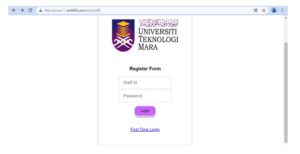
Figure 1. EET Online Speaking Portal login page
Figure 1 illustrates the login page whereby students can register themselves as users before utilising this portal.

Figure 2. EET Online Speaking Portal first page
Figure 2 brings on the first page to welcome users to the speaking portal. The left side of the page comprises the sets and tasks made available for the test-takers to use and practise. For each task, four sets for them to try out. The pre-test and post-test indicated were meant to research this portal’s effectiveness and intervention.
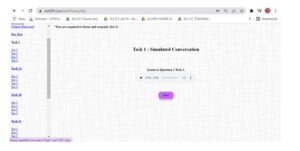
Figure 3. Task 1.
Figure 3 highlights the first task, which is a simulated conversation between the interviewer and the test-takers. Questions could easily range from small talk on a specific issue or task.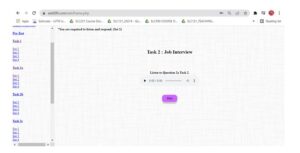
Figure 4. Tasks 2a, 2b, and 2c.
Figure 4, meanwhile,, consists of tasks 2a, 2b and 2c. These three include more of a job interview.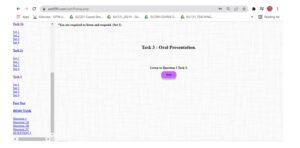
Figure 5a. Task 3
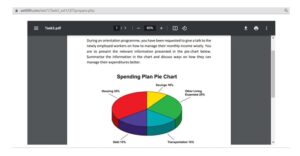
Figure 5b. Task 3
Figures 5a and 5b are based on Task 3: Oral Presentation, which seeks to test the test-takers speaking skills in presenting a given graphic simulation in the form of a chart and graph.
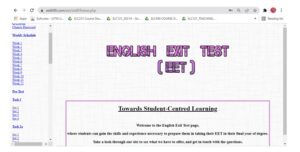
Figure 6. Instructor log-in interface
Figure 6 is the interface one view when one is logged in as the instructor. On the side, there is a weekly schedule for the users to refer to as a reference for each weekly input to cater to the EET.

Figure 7a. Week 1 input and the video
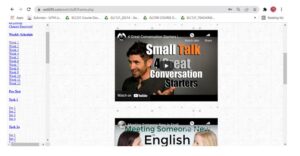
Figure 7b. Week 1 input and the video
Figures 7a and 7b are a sample of Week 1 input and the video to help the test-takers in being able to familiarize themselves with phrases for conversation starters or small talks in Task 1.

Figure 8. Playlist interface
Figure 8 is the interface clicked upon,that displays the playlist clicked upon and then illustrated the list of students’ matrix numbers or test-takers. The instructor must click on the selected matrix no, and the audio will be audible to the instructor.
More importantly, the audio is the recorded response within the stipulated time, as suggested in the EET format. Similarly, for each task displayed, the audio stored could be played, and the instructor can give feedback based on the Speaking EET rubrics.
Conclusion
The portal’s creation is to improve the EET test-takers performance in speaking by going through a series of practices from the portal’s accessible sets of exercises. It provides opportunities for EET takers to practiseat their own pace without relying on English instructors to offer the related courses. Byamiliarising themselves with the questions from this portal can assist the test takers in acquiring the skills and gaining confidence when they take the real EET.
The EET Online Speaking Portal is still in its initial stage and will be improved and enhanced in the future through the feedback collected from the users. The users’ feedback can help them identify their lacks and needs.
Acknowledgment
The authors wish to thank Universiti Teknologi MARA, Cawangan Pulau Pinang, for its support and assistance in the materialization of this research.
References
- Ahmad Fauzi Mohd Ayub, Rohani Ahmad Tarmizi, Wan Marzuki Wan Jaafar, Wan Zah Wan Ali, & Wong, S. L. (2010). Factors influencing students’ use of a Learning Management System Portal: a perspective from Higher Education students. International Journal of Education and Information Technologies, Pp, 4(2), 100–108.
- Akademi Pengajian Bahasa. (2016). English Exit Test.
- Baharuddin, S. S., & Rashid, S. M. (2014). Journal of Language and Communication, 1(2) (2014) ISSN: 2289-649X ©Universiti Putra Malaysia Press. Journal of Language and Communication, 1(2), 137–154.
- Farina Tazijan, Rofiza Aboo Bakar, & Nor Fazlin Mohd Ramli. (2022). The Drive of Digital Literacy Skills in the 21st Century. International Journal of Practices in Teaching and Learning (IJPTL), 2(1), 1–7.
- Hal Ehwal Akademik UiTM Shah Alam. (2016). UiTM English Exit Test The Official Guide.
- Ikhsanudin Ikhsanudin, & Dwi Susanto Ali Purwoko. (2022). Developing Online Speaking Activities Via TikTok: Project-based Learning. International Journal of Practices in Teaching and Learning (IJPTL), 2(1), 8–14.
- Issham Ismail, Temoli Gunasegaran, & Rozhan Mohd Idrus. (2010). Does e-Learning portal add value to adult learners? Current Research Journal of Social Sciences, 2(5), 276–281.
- Ming Chee, H., Wou Onn, C., & Pei Hwa, S. (n.d.). Implementation of LMS among Private Higher Learning Institutions in Malaysia. Retrieved from http://mmlscyber.mmu.edu.my/
- Ministry of Education Malaysia Higher Education (MOHE). (2018). Malaysia Education Blueprint 2015-2025 (Higher Education). 2025.
- Ministry of Higher Education. (2012). The National graduate Employability blueprint 2012- 2017. Ministry of Higer Education Putrajaya.
- Rebecca Rajaendram. (2016). English skills vital for all. Sunday, 12 June 2016.
- Richards, J. (2009). Teaching Listening and Speaking From Theory to Practice.
- Sarah, S., Johari, M., & Ismail, I. (2011). The effectiveness of e-learning portal in distance education as perceived by students in Universiti Sains Malaysia. Malaysian Journal of Distance Education, 13(1), 47–57.
- Suzana Ab. Rahim, Farina Nozakiah Tazijan, Rushita Ismail, & Emily Jothee Mathai. (2014). Technology Enabled Learning and Teaching (TELT): Culture in the Making!. Asian Journal of Education and E-Learning, 2(6), 431–437.
- Suzana Ab. Rahim, Mah Boon Yih, & Zarina Suriya Ramlan. (2017). English Exit Test (EET) And Competence-Based English Test (CBET) As Verbal Competence Measures For Employability: A Comparative Systematic Review. International Academic Research Journal of Social Science, 3(1), 135–141. Retrieved from http://www.iarjournal.com/wp-content/uploads/IARJSS2017_1_135-141.pdf
- Urmston, A. (2003). The Effects of having an English Language Exit Test on Teaching, Learning and Assessment at Tertiary Level in Hong Kong. (2001), 1–10.
- Zuraidah Don. (2016). CEFR familiarisation training – tertiary.












